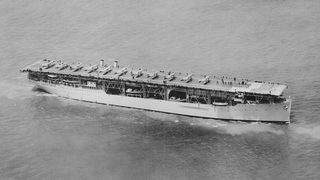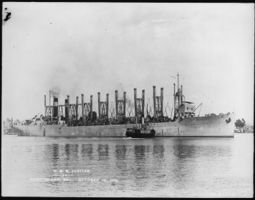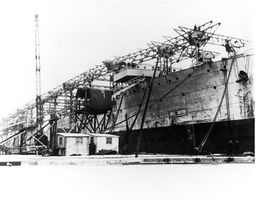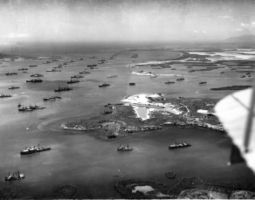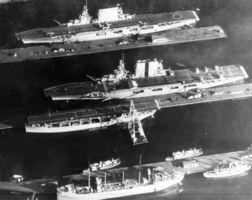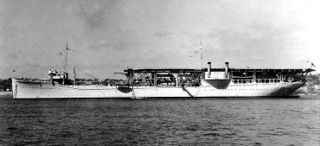Langley
| Revision as of 20:50, 17 August 2015 added historical images | Revision as of 14:56, 25 August 2015 | |||
| Line 4: | Line 4: | |||
| |InTheGame_performance= | |InTheGame_performance= | |||
| ? | The Langley has the distinction of being the slowest aircraft carrier in the game. If discovered, it can't get away from anything. | + | The Langley has the unfortunate distinction of being the slowest aircraft carrier in the game. If discovered, it can't get away from anything - not even ''battleships''. Keep an eye on your map, start moving long before enemies get near detection range. Only able to deploy one squadron of fighters and torpedo bombers each, Langley commanders will have to make sure that every strike mission counts. The carrier itself starts with no AA armament whatsoever. The hull upgrade adds four 127 mm cannons which will sink a heavily damaged destroyer on occasion, but their range is pitiful. Your best bet is to stay back, stay hidden, and make good use of the aircraft. | |
| ? | ||||
| '''Pros:''' | '''Pros:''' | |||
| ? | * Has aircraft | + | * Has aircraft in large squadrons where most ships of that tier have little or no anti-aircraft capabilities. | |
| * Not easily detected, around 10km detection from the surface if exposed. | * Not easily detected, around 10km detection from the surface if exposed. | |||
| ? | * | + | * Can one-shot anything it can connect a good torpedo salvo with | |
| + | ||||
| '''Cons:''' | '''Cons:''' | |||
| ? | * | + | * Only able to deploy 2 squadrons somewhat limit its contribution potential | |
| ? | * Incredibly slow, top speed being around 16 knots | + | * Incredibly slow, top speed being around 16 knots, and slows rapidly while turning | |
| * Clumsy compared to other carriers, taking more space than most battleships to turn around completely. | * Clumsy compared to other carriers, taking more space than most battleships to turn around completely. | |||
Revision as of 14:56, 25 August 2015
<value_unset_error>
Overview
Mobility
| kt Max Speed |
| s Rudder Shift Time |
| m Turn Radius |
Armor
| - mm Hull Armor |
| - mm Citadel Armor |
| - mm Deck Armor |
| - mm Extremities Armor |
Primary Armament
| Guns |
Secondary Armament
| Guns |
Torpedoes
| Torpedoes |
Aircrafts
| Recon Squadrons |
Visibility
| km Aerial Detection Range |
| km Surface Detection Range |
<value_unset_error>
Modules
Compatible Equipment
Player Opinion
Performance
The Langley has the unfortunate distinction of being the slowest aircraft carrier in the game. If discovered, it can't get away from anything - not even battleships. Keep an eye on your map, start moving long before enemies get near detection range. Only able to deploy one squadron of fighters and torpedo bombers each, Langley commanders will have to make sure that every strike mission counts. The carrier itself starts with no AA armament whatsoever. The hull upgrade adds four 127 mm cannons which will sink a heavily damaged destroyer on occasion, but their range is pitiful. Your best bet is to stay back, stay hidden, and make good use of the aircraft.
Pros:
- Has aircraft in large squadrons where most ships of that tier have little or no anti-aircraft capabilities.
- Not easily detected, around 10km detection from the surface if exposed.
- Can one-shot anything it can connect a good torpedo salvo with
Cons:
- Only able to deploy 2 squadrons somewhat limit its contribution potential
- Incredibly slow, top speed being around 16 knots, and slows rapidly while turning
- Clumsy compared to other carriers, taking more space than most battleships to turn around completely.
Early Research
- Research the Martin T3M torpedo bombers first for a 44% increase in damage, and the increased survivability doesn't hurt either.
- Research the Curtiss F6C-1 fighters next for a 35% increase in hit points and a small speed increase.
- Research the B hull.
- Proceed to the Bogue.
Historical Info
USS Langley (CV-1/AV-3) was the United States Navy's first aircraft carrier, converted in 1920 from the collier USS Jupiter (AC-3), and also the U.S. Navy's first electrically propelled ship. Conversion of another collier was planned but canceled when the Washington Naval Treaty required the cancellation of the partially built battlecruisers Lexington and Saratoga, freeing up their hulls for conversion to the aircraft carriers CV-2 and CV-3. Langley was named after Samuel Pierpont Langley, an American aviation pioneer. Following another conversion, to a seaplane tender, Langley fought in World War II. On 27 February 1942, she was attacked by dive bombers of the Japanese 21st and 23rd Naval Air Flotillas and so badly damaged that she had to be scuttled by her escorts.
Historical Gallery
| Destroyers | |
| Cruisers | |
| Battleship | |
| Aircraft Carriers |
| USA | |
| UK | |
| USSR | |
| Japan |
Category:
